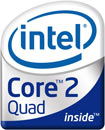Core 2 Extreme QX6700 Quad-Core Kentsfield Performance Preview
Introduction and Configurations
 Though we're running the risk of sounding a bit platitudinal, this is definitely the IDF moment we're sure many of you have been waiting for. We've reported to you on Intel's various technology announcements and architectural initiatives over the past few days. And, from what we could garner from our sessions with Intel at this fall's IDF, the company certainly has a lot of bleeding-edge technology on tap that by all rights should dramatically affect the computing industry landscape for years to come.
Though we're running the risk of sounding a bit platitudinal, this is definitely the IDF moment we're sure many of you have been waiting for. We've reported to you on Intel's various technology announcements and architectural initiatives over the past few days. And, from what we could garner from our sessions with Intel at this fall's IDF, the company certainly has a lot of bleeding-edge technology on tap that by all rights should dramatically affect the computing industry landscape for years to come.
We've heard from both sides of the fence, nearly all year long, that the age of the multi-core processor is upon us and multi-threaded applications are the wave of the future. The benefits of SMP (symmetric multi-processing) have been know for many years now but until only recently have desktop applications and usage models been able to take advantage of multi-thread capable systems. The advent of the dual-core X86 desktop processor has ushered in a whole new era of computing architectures, performance levels, capabilities in software and of course it doesn't just end there.
Intel's quad-core processor, code named "Kentsfield" is going to be launched in volume this November. It  is targeted at raising the bar once again, potentially doubling the performance level of the Core 2 Duo architecture that was marked clearly as the most successful processor product launch in Intel's long history. Kentsfield is in fact an integration of two dual-core Core 2 Duo die on a single package substrate and those cores then share a common front side system bus. That's a pair of dual-core CPUs in a single LGA775 socket and on paper the specs are more than promising.
is targeted at raising the bar once again, potentially doubling the performance level of the Core 2 Duo architecture that was marked clearly as the most successful processor product launch in Intel's long history. Kentsfield is in fact an integration of two dual-core Core 2 Duo die on a single package substrate and those cores then share a common front side system bus. That's a pair of dual-core CPUs in a single LGA775 socket and on paper the specs are more than promising.
But can we really exploit the available throughput of a quad-core Intel Core 2 processor? Will this new high-end CPU aimed to woo the hearts of the computing enthusiast, with its subtly-sexy "QX" branding, really make good on its perceived benefits in the benchmarks and real-world usage scenarios? Intel allowed us some behind closed doors private time benchmarking systems based on their new Kentsfield Core 2 Extreme QX6700 processor. The following pages are intended to offer you some insight into what a "controlled" benchmarking effort with Kentsfield was able to yield for us in various performance metrics. Though Intel furnished us with all the test system configured in the following benchmarks, we're very confident in the numbers, as we were at last year's IDF when we first saw Core 2 Duo in action. This time around, it's a quad-core assault.
|
|
|
| Processor |
Core 2 Extreme QX6700 (Quad-Core, 2.66GHz, 8MB Cache, 1066MHz FSB) |
Core 2 Extreme X6800 (Dual-Core, 2.93GHz, 4MB Cache, 1066MHz FSB) |
| Motherboard | Intel BadAxe 2 D975XBX2 Rev.303 | |
| BIOS Revision | BX97520J.86A.1446.2006.0913.1039 | |
| Chipset Drivers | Intel Chipset Software Installation Utility v7.2.2.1007 | |
| Graphics Adapter | eVGA GeForce 7950 GX2 | |
| Graphics Driver | Forceware v91.47 | |
| Memory | 2GB (2 x 1GB) Corsair TWIN2X2048-8500C5 @ DDR2-800 4-4-4-12 | |
| Hard Drive | Seagate Barracuda 320GB 7200.10 (7200 RPM) | |
| Storage Driver | Intel Matrix Storage Console v5.5 | |
| Audio Driver | v5.10.5143 | |
| Optical Drive | Sony DVD-ROM DDU1615 | |
| DirectX Version | DX9.0c August 2006 Redistribution | |
| Operating System | Windows XP Professional w/ SP2 | |
Intel's own D975XBX2 "BadAxe" motherboard was configured as a test-bed for our Kentsfield QX6700 test system. The machine was well endowed with a dual-GPU GeForce 7950GX2 graphics card in a single PCI Express X16 slot and a 2Gig Corsair PC8500 DDR2 RAM kit. On-board integrated audio was utilized and a single Seagate Barracuda 7200.10 320Gig drive was configured with Windows XP SP2. On with the benchmarks...











